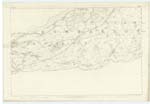OS1/9/10/33
| List of names as written | Various modes of spelling | Authorities for spelling | Situation | Description remarks |
|---|---|---|---|---|
| Barhill Fort (Remains of) (Continued | 025 | passing by the northern side of the Fort while the other led directly through it. Both lines appear to have been perfectly distinct when Horsley visited the spot. - The only inscription which can be distinctly traced to Barhill is one taken notice of by Gordon, & which he describes as being cut upon the fragment of a pillar - Some vaults were, about the year 1790 laid open on Barhill, covered with flat bricks, as were those at Duntocher. Roman coins have likewise been met with at the same spot several of which - denarii of Trajan, Hadrian and Antoninus Pius, in the highest state of preservation - were procured by Professor Anderson, and are now deposited at Glasgow, in the museum of the institution which bears his name. This Fort stands upon that part of the Bar Hill which is called "Castle Hill" (the description of which see) and terminated at the peak described on the other side. This Station is, from being on the Castle Hill of Barhill, often commonly called the "Castlehill Fort", but the best authorities both documentary and personal, call it by its proper name of "Barhill Fort". The Remains of the Fort are, with the exception of the inner side of the ditch on part of the north & the west sides, generally faint, but plainly discernable, as represented in position on the Examination Trace. There appears at the north-east angle of the Station, on the outer sides, remains as of a treble ditch. These are very distinct but not at all steep. (See Notes in Cal. [Caledonia] Romana, & on the other side, with reference to the north side not being defended with the treble ditch). There is no assistance to be had from authorities in the district as to whether the parts in question are or are not remains of a treble line of ditches at this part. The near approach of these faint traces to a regular form and being nearly parallel with the remains of the inner trench, as the representation on the Trace, which is a careful survey, shews would lead to infer that they formed a part of the Fort at one time. Near the centre of the Station there is a slope falling towards the south and extending across nearly from east to west, which it is doubtful whether from the changes the entire Fort has undergone, it formed a part of the inner works or is merely a natural feature. It has been shewn as it appears on the ground, but it will be seen that it gives the fortification an unnatural appearance. The southern part of the Fort, on which there is a fence, is very faint. No remains of the Military Way passing either through or on the north side of the Fort are to be seen, nor is the Site known. During the winter of this year the Fort was dug & wrought with a pickaxe for the purpose of looking for some Roman remains, but nothing of importance was found except a stone foundation of a loose kind. The traces of ancient buildings within the fort have disappeared long since, & with them almost everything of interest except what remains of the "Barhill Fort" at the present time (1839). The existing remains are annually ploughed over in the course of cultivation, the whole of the ground in the field in which the Fort stands being arable land. The remains on the east side, near the centre, seem to have been an entrance to the Fort. They are very [faint]. |
Continued entries/extra info
[Page] 33Co. [County] Dumbarton -- Kirkintilloch Parish
Transcriber's notes
Continued from page 32Transcribers who have contributed to this page.
Alison James- Moderator
Location information for this page.
Linked mapsheets.




